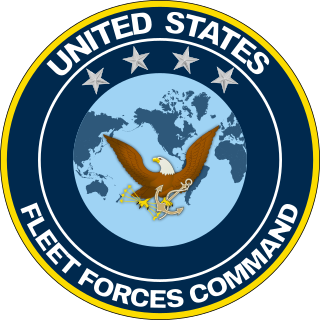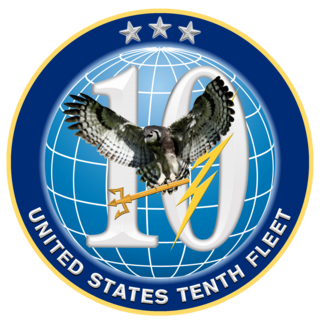
The United States Fleet Forces Command (USFF) is a service component command of the United States Navy that provides naval forces to a wide variety of U.S. forces. The naval resources may be allocated to Combatant Commanders such as United States Northern Command (USNORTHCOM) under the authority of the Secretary of Defense. Originally formed as United States Atlantic Fleet (USLANTFLT) in 1906, it has been an integral part of the defense of the United States of America since the early 20th century. In 2002, the Fleet comprised over 118,000 Navy and Marine Corps personnel serving on 186 ships and in 1,300 aircraft, with an area of responsibility ranging over most of the Atlantic Ocean from the North Pole to the South Pole, the Caribbean Sea, Gulf of Mexico, and the waters of the Pacific Ocean along the coasts of Central and South America.

The second USS La Salle (LPD-3/AGF-3) was built as a Raleigh-class amphibious transport dock and entered service with the United States Navy in 1964. La Salle was named for the city in Illinois that was in turn named after René-Robert Cavelier, Sieur de La Salle. La Salle saw service in the Caribbean Sea, Gulf of Mexico and throughout international waters in the Middle East. The vessel served as a command ship for Joint Task Force Middle East. In 2005 the ship was decommissioned and sunk as a target ship off the Atlantic coast of the United States in 2007.

The Sixth Fleet is a numbered fleet of the United States Navy operating as part of United States Naval Forces Europe-Africa. The Sixth Fleet is headquartered at Naval Support Activity Naples, Italy. The officially stated mission of the Sixth Fleet in 2011 is that it "conducts the full range of Maritime Operations and Theater Security Cooperation missions, in concert with coalition, joint, interagency, and other parties, in order to advance security and stability in Europe and Africa." The current commander of the Sixth Fleet is Vice Admiral Thomas E. Ishee.

The Seventh Fleet is a numbered fleet of the United States Navy. It is headquartered at U.S. Fleet Activities Yokosuka, in Yokosuka, Kanagawa Prefecture, Japan. It is part of the United States Pacific Fleet. At present, it is the largest of the forward-deployed U.S. fleets, with 50 to 70 ships, 150 aircraft and 27,000 Sailors and Marines. Its principal responsibilities are to provide joint command in natural disaster or military operations and operational command of all U.S. naval forces in the region.

The Fifth Fleet is a numbered fleet of the United States Navy. Its area of responsibility encompasses approximately 2.5 million square miles, and includes the Persian Gulf, Red Sea, Arabian Sea, and parts of the Indian Ocean. It shares a commander and headquarters with U.S. Naval Forces Central Command (NAVCENT) in Bahrain. Fifth Fleet/NAVCENT is a component command of, and reports to, U.S. Central Command (CENTCOM).

USS Mount Whitney is one of two Blue Ridge-class amphibious command ships of the United States Navy and is the flagship and command ship of the United States Sixth Fleet. USS Mount Whitney also serves as the Afloat Command Platform (ACP) of Naval Striking and Support Forces NATO (STRIKFORNATO). The ship had previously served for years as the COMSTRIKFLTLANT(NATO Designation) / US Second Fleet's command ship. She is one of only a few commissioned ships to be assigned to Military Sealift Command.

The United States Naval Forces Europe and Africa (NAVEUR-NAVAF), is the United States Navy component command of the United States European Command and United States Africa Command. Prior to 2020, NAVEUR-NAVAF was previously referred to as United States Naval Forces Europe – Naval Forces Africa and sometimes referred to as United States Naval Forces Europe – Africa.

The Supreme Allied Commander Atlantic (SACLANT) was one of two supreme commanders of the North Atlantic Treaty Organisation (NATO), the other being the Supreme Allied Commander Europe (SACEUR). The SACLANT led Allied Command Atlantic was based at Norfolk, Virginia. The entire command was routinely referred to as 'SACLANT'.

USS Pocono (AGC-16) was an Adirondack-class amphibious force command ship named after a range of mountains in Eastern Pennsylvania. She was designed as an amphibious force flagship, a floating command post with advanced communications equipment and extensive combat information spaces to be used by the amphibious forces commander and landing force commander during large-scale operations.

United States Naval Forces Central Command (NAVCENT) is the United States Navy element of United States Central Command (USCENTCOM). Its area of responsibility includes the Red Sea, Gulf of Oman, Persian Gulf, and Arabian Sea. It consists of the United States Fifth Fleet and several other subordinate task forces, including Combined Task Force 150, Combined Task Force 158 and others.
The structure of the United States Navy consists of four main bodies: the Office of the Secretary of the Navy, the Office of the Chief of Naval Operations, the operating forces, and the Shore Establishment.

The U.S. Tenth Fleet is a functional formation and a numbered fleet in the United States Navy. It was first created as an anti-submarine warfare coordinating organization during the Battle of the Atlantic in the Second World War. It was reactivated as a force provider for Fleet Cyber Command on 29 January 2010. U.S. Tenth Fleet serves as the numbered fleet for U.S. Fleet Cyber Command and exercises operational control of assigned naval forces to coordinate with other naval, coalition and Joint Task Forces to execute the full spectrum of cyber, electronic warfare, information operations, and signal intelligence capabilities and missions across the cyber, electromagnetic, and space domains.

Admiral Jerauld Wright was an officer in the United States Navy. He served as the Commander-in-Chief of the United States Atlantic Command (CINCLANT) and the Commander-in-Chief of the United States Atlantic Fleet (CINCLANTFLT), and became the second Supreme Allied Commander Atlantic (SACLANT) for the North Atlantic Treaty Organization (NATO), from April 1, 1954, to March 1, 1960, serving longer in these three positions than anyone else in history.
Task Force 61 (CTF-61) is a task force of the United States Navy that today denotes what used to be designated the Mediterranean Amphibious ready group (MARG) of the United States Sixth Fleet. It is composed of approximately three Amphibious assault ships, but in 2008 is designated the Expeditionary Strike Group that includes their embarked landing craft. From these ships, United States Marine Corps ground forces can move ashore by sea and air in amphibious assault or emergency evacuation missions. Once ashore, the ships of Task Force 61 are able to logistically support the ground forces, until the objective of the landing has been accomplished.

Expeditionary Strike Group SEVEN/Task Force 76 is a United States Navy task force. It is part of the United States Seventh Fleet and the USN's only permanently forward-deployed expeditionary strike group. It is based at the White Beach Naval Facility at the end of the Katsuren Peninsula in Uruma City, Okinawa, Japan.

Carrier Strike Group 14 was a U.S. Navy carrier strike group. The group was for some time the only U.S. carrier strike group that did not have an assigned aircraft carrier or carrier air wing. As of December 2010, it directed the cruisers USS Gettysburg (CG-64) and USS Philippine Sea (CG-58). Carrier Strike Group 14 was seemingly last based at Naval Station Mayport. Without a carrier flagship, it did not conduct the typical deployments of other carrier strike groups; instead, its two cruisers made independent voyages.

Commander, Carrier Strike Group FOUR is the U.S. Fleet Forces Command formation charged with training and certifying Atlantic Fleet Carrier Strike Groups, Amphibious Ready Groups, and independently deploying surface ships. Its mission is to "Conduct safe and effective Strike Force Training of the Atlantic Fleet."

Joint Force Command - Norfolk (JFC-NF) is a joint operational level command part of the NATO Military Command Structure under Allied Command Operations. Its headquarters is located in Norfolk, Virginia, United States.

Daryl Lane Caudle is a United States Navy admiral who is the 35th commander of United States Fleet Forces Command since December 7, 2021. He most recently served as commander of Naval Submarine Forces (COMSUBFOR), Commander, Submarine Force Atlantic (COMSUBLANT) and Commander, Allied Submarine Command (ASC). As COMSUBFOR, he was the undersea domain lead, and is responsible for the submarine force's strategic vision. As COMSUBLANT, he commanded all Atlantic-based U.S. submarines, their crews and supporting shore activities. These responsibilities also include duties as commander, Task Force (CTF) 114, CTF 88, and CTF 46. As commander, Allied Submarine Command, he was the principal undersea warfare advisor to all North Atlantic Treaty Organization (NATO) strategic commanders.





















